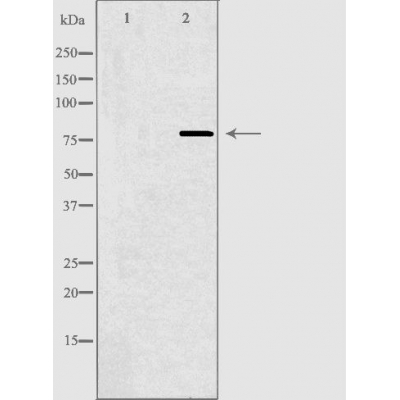BARD1 Antibody - #DF3605
| 製品: | BARD1 Antibody |
| カタログ: | DF3605 |
| タンパク質の説明: | Rabbit polyclonal antibody to BARD1 |
| アプリケーション: | WB IF/ICC |
| 反応性: | Human |
| 分子量: | 79 KD; 87kD(Calculated). |
| ユニプロット: | Q99728 |
| RRID: | AB_2835977 |
製品説明
*The optimal dilutions should be determined by the end user. For optimal experimental results, antibody reuse is not recommended.
*Tips:
WB: For western blot detection of denatured protein samples. IHC: For immunohistochemical detection of paraffin sections (IHC-p) or frozen sections (IHC-f) of tissue samples. IF/ICC: For immunofluorescence detection of cell samples. ELISA(peptide): For ELISA detection of antigenic peptide.
引用形式: Affinity Biosciences Cat# DF3605, RRID:AB_2835977.
折りたたみ/展開
BARD-1; Bard1; BARD1_HUMAN; BRCA1 associated RING domain 1; BRCA1 associated RING domain gene 1; BRCA1 associated RING domain protein 1; BRCA1-associated RING domain protein 1;
免疫原
A synthesized peptide derived from human BARD1, corresponding to a region within the internal amino acids.
- Q99728 BARD1_HUMAN:
- Protein BLAST With
- NCBI/
- ExPASy/
- Uniprot
MPDNRQPRNRQPRIRSGNEPRSAPAMEPDGRGAWAHSRAALDRLEKLLRCSRCTNILREPVCLGGCEHIFCSNCVSDCIGTGCPVCYTPAWIQDLKINRQLDSMIQLCSKLRNLLHDNELSDLKEDKPRKSLFNDAGNKKNSIKMWFSPRSKKVRYVVSKASVQTQPAIKKDASAQQDSYEFVSPSPPADVSERAKKASARSGKKQKKKTLAEINQKWNLEAEKEDGEFDSKEESKQKLVSFCSQPSVISSPQINGEIDLLASGSLTESECFGSLTEVSLPLAEQIESPDTKSRNEVVTPEKVCKNYLTSKKSLPLENNGKRGHHNRLSSPISKRCRTSILSTSGDFVKQTVPSENIPLPECSSPPSCKRKVGGTSGRKNSNMSDEFISLSPGTPPSTLSSSSYRRVMSSPSAMKLLPNMAVKRNHRGETLLHIASIKGDIPSVEYLLQNGSDPNVKDHAGWTPLHEACNHGHLKVVELLLQHKALVNTTGYQNDSPLHDAAKNGHVDIVKLLLSYGASRNAVNIFGLRPVDYTDDESMKSLLLLPEKNESSSASHCSVMNTGQRRDGPLVLIGSGLSSEQQKMLSELAVILKAKKYTEFDSTVTHVVVPGDAVQSTLKCMLGILNGCWILKFEWVKACLRRKVCEQEEKYEIPEGPRRSRLNREQLLPKLFDGCYFYLWGTFKHHPKDNLIKLVTAGGGQILSRKPKPDSDVTQTINTVAYHARPDSDQRFCTQYIIYEDLCNYHPERVRQGKVWKAPSSWFIDCVMSFELLPLDS
研究背景
E3 ubiquitin-protein ligase. The BRCA1-BARD1 heterodimer specifically mediates the formation of 'Lys-6'-linked polyubiquitin chains and coordinates a diverse range of cellular pathways such as DNA damage repair, ubiquitination and transcriptional regulation to maintain genomic stability. Plays a central role in the control of the cell cycle in response to DNA damage. Acts by mediating ubiquitin E3 ligase activity that is required for its tumor suppressor function. Also forms a heterodimer with CSTF1/CSTF-50 to modulate mRNA processing and RNAP II stability by inhibiting pre-mRNA 3' cleavage.
Processed during apoptosis. The homodimer is more susceptible to proteolytic cleavage than the BARD1/BRCA1 heterodimer.
Nucleus.
Note: During S phase of the cell cycle, colocalizes with BRCA1 into discrete subnuclear foci. Can translocate to the cytoplasm. Localizes at sites of DNA damage at double-strand breaks (DSBs); recruitment to DNA damage sites is mediated by the BRCA1-A complex.
研究領域
· Genetic Information Processing > Replication and repair > Homologous recombination.
Restrictive clause
Affinity Biosciences tests all products strictly. Citations are provided as a resource for additional applications that have not been validated by Affinity Biosciences. Please choose the appropriate format for each application and consult Materials and Methods sections for additional details about the use of any product in these publications.
For Research Use Only.
Not for use in diagnostic or therapeutic procedures. Not for resale. Not for distribution without written consent. Affinity Biosciences will not be held responsible for patent infringement or other violations that may occur with the use of our products. Affinity Biosciences, Affinity Biosciences Logo and all other trademarks are the property of Affinity Biosciences LTD.
